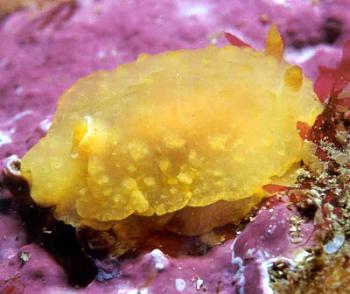
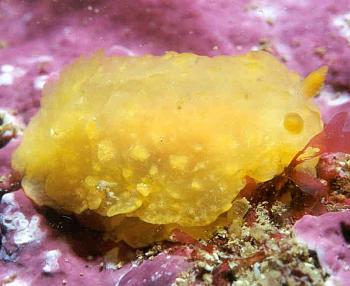
Doriopsilla pelseneeri
d'Oliveira, 1895
Order: NUDIBRANCHIA
Suborder: DORIDINA
Superfamily: EUDORIDOIDEA
Family: Dendrodorididae
DISTRIBUTION
Known from north Atlantic coast of Portugal & Spain, Mediterranean coast of Spain & France. Reported here from Atlantic coast of France for first time.
PHOTO
Dive site: "le mur", Hendaye, south west France. 2cm long, Depth: 12m, 03/07/00. Photos: Jean-Pierre Bielecki.
The background colour varies with size. Small animals are uniformly white, medium sized ones yellow or orange and largest ones red. There is always a white ring around the gill pocket. Dorsum covered with large irregularly shaped spiculate tubercles. The gills and thinophores are translucent, with a similar colour to that of the mantle. The sympatric Doriopsilla areolata differs in usually having a reticulate white pattern on the mantle, and never has a white ring edging the gill pocket. Also in D. pelseneeri the dorsal tubercles are large and irregular, not low and rounded as in D. areolata, and the oral tentacles are quite different. In D. pelseneeri the oral tentacles are separate, grooved and covered by the anterior edge of the foot, while in D. areolata they are fused, ungrooved and not covered by the foot.
Reference:
• Valdes, A., & J. Ortea (1997) Review of the genus Doriopsilla Bergh, 1880 (Gastropoda: Nudibranchia) in the Atlantic Ocean. The Veliger, 40(3): 240-254.
Rudman, W.B., 2001 (March 18) Doriopsilla pelseneeri d'Oliveira, 1895. [In] Sea Slug Forum. Australian Museum, Sydney. Available from http://www.seaslugforum.net/find/doripels
Related messages
Doriopsilla pelseneeri from Portugal
May 29, 2007
From: Joao Pedro Silva
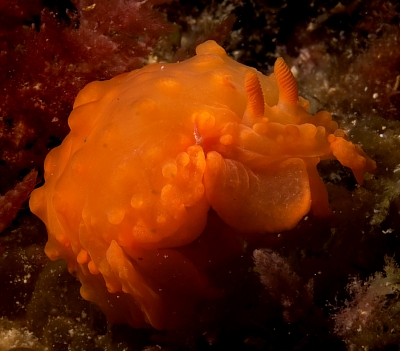
Dear Bill,
Here's one of the several specimens of Doriopsilla pelseneeri I've seen during this dive. There were several dozens around and they were surprisingly large. At first I thought it was another color form of Doriopsilla areolata but it missed the typical reticulated white lines I'm used to see in local specimens.
Locality: Baleeira dive spot, Sesimbra, 8 metres, Portugal, Atlantic, 9 September 2006, rocky bottom. Length: 4cm. Photographer: Joao Pedro Tojal Loia Soares Silva.
Cheers,
Joao Pedro
jpsilva@uwphotographer.net
Silva, J. P., 2007 (May 29) Doriopsilla pelseneeri from Portugal. [Message in] Sea Slug Forum. Australian Museum, Sydney. Available from http://www.seaslugforum.net/find/18607Thanks Joao,
Bill Rudman
Rudman, W.B., 2007 (May 29). Comment on Doriopsilla pelseneeri from Portugal by Joao Pedro Silva. [Message in] Sea Slug Forum. Australian Museum, Sydney. Available from http://www.seaslugforum.net/find/18607Re: Doriopsilla pelseneeri from Spain
July 28, 2003
From: Ricardo Roberto Fernández
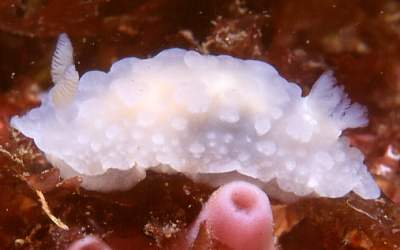
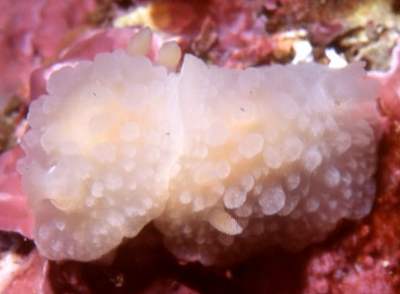
Dear Dr. Rudman,
Thanks a lot for identifying the orange nudibranch that was really puzzling me. I enclose another two photographs of white specimens. I had thought these were Aldisa zetlandica, but I wasn't too sure. I have always thought they looked like the orange one and that they could be the same species. What do you think? I think they are the same, what you have identified as Doriopsilla pelseneeri, but in different colour. The white ones, and the orange one(much larger than the first) are quite common here, in Asturias, but I have never seen the yellow ones you say. What could you comment about this? I'm looking forward to read about your opinion!
Thanks again for your help.
Ricardo Roberto Fernández
rirober@telecable.es
Fernández, R. R., 2003 (Jul 28) Re: Doriopsilla pelseneeri from Spain. [Message in] Sea Slug Forum. Australian Museum, Sydney. Available from http://www.seaslugforum.net/find/10551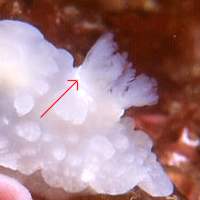
Dear Ricardo,
Valdes & Ortea (1997) in their review of the Atlantic species of Doriopsilla suggest they change colour from white to yellow or orange as they grow in size. The largest animals found have been red. They usually have a white edge to the gill pocket which I think I can see in one of your photos. I must say I couldn't see the white edge in your orange photo so it would be interesting to check in live animals whether the white line - or a trace of it - is always present. Concerning colour changes. I don't think we know enough about this at present. Its possible that colour in this species is related to pigments they obtain from their food sponge, which might explain why some become yellow and others orange, but we don't know enough about them at present. Related species like Doriopsilla areolata and D. miniata also show similar colour changes.
Best wishes,
Bill Rudman
Doriopsilla pelseneeri from Spain
July 12, 2003
From: Ricardo Roberto Fernández
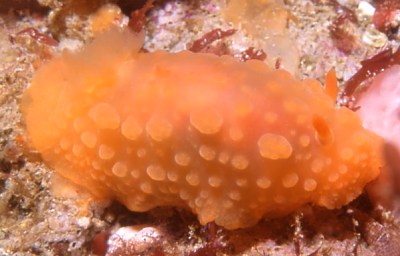
Dear Dr. Rudman,
Quite recently I came across this slug. I think it is Archidoris pseudoargus - 'the sea lemon', but I'm not quite sure. Could you help identifying it? It was found in Oviñana, Asturias, on the Northern coast of Spain. It was about 5 metres deep and its size was about three centimetres.
Thank you very much.
Ricardo Roberto Fernández.
rirober@telecable.es
Fernández, R.R., 2003 (Jul 12) Doriopsilla pelseneeri from Spain. [Message in] Sea Slug Forum. Australian Museum, Sydney. Available from http://www.seaslugforum.net/find/10181Dear Ricardo,
I think this is Doriopsilla pelseneeri. It's nice to get an orange colour form to go with the photos of yellow ones we already have on the Forum. I'm afraid 'common names' like 'sea lemon' are quite confusing. Not only is the name used for different species in the north eastern Atlantic but is also used for 3 or 3 quite different species on the west coast of North America.
Best wishes,
Bill Rudman
Re: Yellow dorid from SW France
March 22, 2001
From: Juan Lucas Cervera
Dear Bill,
Jean-Pierre's animal is Doriopsilla pelseneeri d'Oliveira, 1895. This species has no white marks or reticulation. Doriopsilla rarispinosa, according Angel Valdes is a junior synonym of D. areolata.
For more information see:
Valdes, A., & J. Ortea. 1997. Review of the genus Doriopsilla Bergh, 1880 (Gastropoda: Nudibranchia) in the Atlantic Ocean. The Veliger, 40(3): 240-254.
I hope this can help you.
Cheers.
Lucas.
lucas.cervera@uca.es
Cervera, J.L., 2001 (Mar 22) Re: Yellow dorid from SW France. [Message in] Sea Slug Forum. Australian Museum, Sydney. Available from http://www.seaslugforum.net/find/4000Thanks Lucas,
Bill Rudman
Re: Yellow Doriopsilla
March 22, 2001
From: Angel Valdés
Dear Bill,
I just came back from a trip to the LA Museum of Natural History. I took a look at Jean-Pierre's message and I am sure the animal in the picture is Doriopsilla pelseneeri d'Oliveira, 1895. This species is easily recognized by the uniform yellowish to reddish coloration with a white ring around the branchial sheath. This white ring is present in all specimens I ever studied and it is not present in
Doriopsilla areolata, the other European species of the genus. In addition, the dorsal tubercles are irregular in shape.
All the best,
Angel
avaldes@CalAcademy.org
Valdés, A. , 2001 (Mar 22) Re: Yellow Doriopsilla. [Message in] Sea Slug Forum. Australian Museum, Sydney. Available from http://www.seaslugforum.net/find/4018Thanks Angel,
Bill Rudman
Yellow dorid from SW France
March 16, 2001
From: Jean-Pierre Bielecki


Dear Bill
Thank you and Bernard for your so complete response in connection with the "poor" parasitized Aeolidiella alderi. Can you help me to identify this yellow Dorid found in the Atlantic.
Date: 03/07/00
Dive site: "le mur", Hendaye, south west France
Size: 2cm
Depth: 12m
Water temperature: 15°C
Best regards
Jean-Pierre
bielecki.jeanpierre@free.fr
Bielecki, J-P,, 2001 (Mar 16) Yellow dorid from SW France. [Message in] Sea Slug Forum. Australian Museum, Sydney. Available from http://www.seaslugforum.net/find/3991Dear Jean-Pierre,
At a quick guess I would say a species of Doriopsilla. It could be a colour form of Doriopsilla areolata Bergh 1880 which is lacking the typical white reticulate pattern on mantle. The only sign of white in this animal is the white edge to gill pocket. There is another yellowish species from the region, Doriopsilla rarispinosa, but it has white pustules and a more translucent mantle.
However I could be quite wrong and I am definitely breaking my own rule about not commenting on animals I know little about, so let's wait until we get a reply from someone who knows about your fauna.
Best wishes,
Bill Rudman
